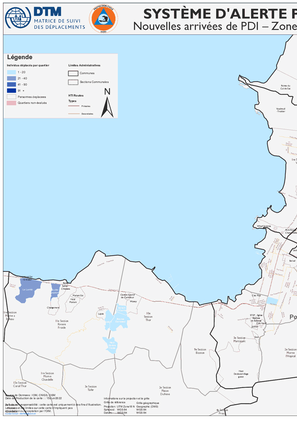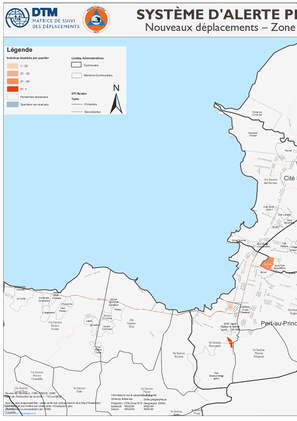-
Countries
-
Data and Analysis
-
Special Focus
-
Crisis Responses
Carte des Nouvelles arrivées des PDI dans la zone métropolitaine de Port-au-Prince, du 21 Mai au 3 Juin 2022.
Carte des Nouveaux Déplacements dans la zone métropolitaine de Port-au-Prince, du 28 Mai au 3 Juin 2022.
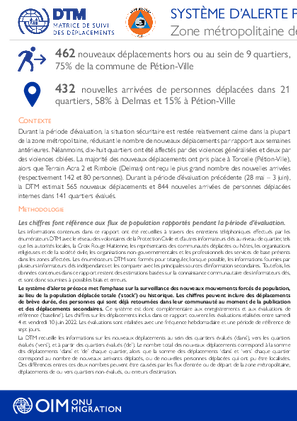
Contact
dtmhaiti@iom.int
Language
English
Location
Haiti
Period Covered
Jun 04 2022
Jun 10 2022
Activity
- Mobility Tracking
- Event Tracking
Durant la période d’évaluation, la situation sécuritaire est restée relativement calme dans la plupart de la zone métropolitaine, réduisant le nombre de nouveaux déplacements par rapport aux semaines antérieures. Néanmoins, dix-huit quartiers ont été affectés par des violences généralisées et deux par des violences ciblées. La majorité des nouveaux déplacements ont pris place à Torcelle (Pétion-Ville), alors que Terrain Acra 2 et Rimbole (Delmas) ont reçu le plus grand nombre des nouvelles arrivées (respectivement 142 et 80 personnes). Durant la période d’évaluation précédente (28 mai – 3 juin), la DTM estimait 565 nouveaux déplacements et 844 nouvelles arrivées de personnes déplacées internes dans 141 quartiers évalués.

Contact
DTM Cameroun, DTMCameroon@iom.int
Language
French
Location
Cameroon
Period Covered
Feb 09 2022
Feb 17 2022
Activity
- Other
- Survey
- Community Perception
- Displacement Solutions
- Mobility Tracking
- Baseline Assessment
Depuis 2014, la région de l’extrême nord du Cameroun est victime d’attaques de groupes armées non étatiques, qui s’ajoutent aux désastres naturelles et des conflits intercommunautaires qui ont crée des crises humanitaires marquées par de mouvements de populations. Des mouvements de retour et des déplacements de courte et longue durée ont continué à être signalés dans les différentes départements de la région. Une proportion importante de personnes déplacées internes, de retournées et refugiés hors camp vivent encore dans les localités dans des conditions de protection et d’assistance inadéquates, le reste de la population déplacée étant dispersée dans les zones rurales dans des familles d’accueils ou sur des sites spontanés de déplacement. Malgré l’amélioration des conditions de sécurité dans certaines localités a permis de faciliter le retour de certains ménages, des nombreux obstacles persistent les empêchant de trouver des solutions durables à leur déplacement.
Afin de trouver des solutions durables des populations mobiles - que ce soit par le retour dans les communautés d’origine, l’intégration locale ou la réinstallation - et de prévenir de nouveaux déplacements dans la région de l’ Extrême Nord, il est essentiel de comprendre les niveaux relatifs de stabilité dans les lieux accueillant des populations déplacées. Par conséquent, l’OIM, a lancé la collecte de données sur l’Indice de stabilité (IS) pour évaluer la stabilité de ces zones accueillant des populations déplacées. L’IS cherche à comprendre quels facteurs influencent la stabilité d’un lieu, ce qui peut éclairer les interventions programmatiques prioritaires le long du lien humanitaire, de paix et de développement (HDP Nexus) afin de renforcer la résilience et la stabilité, fournir des solutions durables et prévenir de futurs déplacements forcés.
During the COVID-19 pandemic, IOM's Displacement Tracking Matrix (DTM), in collaboration with the World Health Organization (WHO), monitors cross-border movements to and from Nigeria's Borno State in north-east Nigeria. Assessments are conducted at Points of Entry located along the border with Cameroon.
A range of data was collected during the assessments to better inform on travellers’ nationalities, sex, reasons for moving, mode of transportation and timeline of movement as shown in figures 2 to 5 on the dashboard.
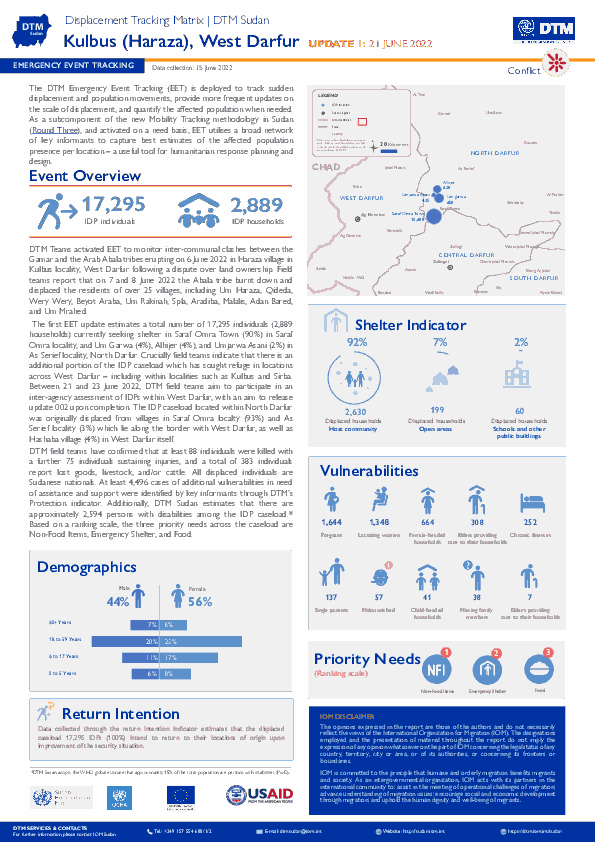
Contact
DTM Ethiopia, SLOAddisAbabaDTM@iom.int
Language
English
Location
Sudan
Snapshot Date
Jun 15 2022
Activity
- Mobility Tracking
- Event Tracking
The DTM Emergency Event Tracking (EET) is deployed to track sudden displacement and population movements, provide more frequent updates on the scale of displacement, and quantify the affected population when needed. As a subcomponent of the new Mobility Tracking methodology in Sudan (Round Three), and activated on a need basis, EET utilises a broad network of key informants to capture best estimates of the affected population presence per location – a useful tool for humanitarian response planning and design.

Contact
DTM Nigeria, AllUsersInDTMNigeria@iom.int
Language
English
Location
Nigeria
Period Covered
Mar 01 2022
Mar 31 2022
Activity
- Flow Monitoring
In order to gain a better understanding of mobility flows and trends throughout West and Central Africa, the International Organization for Migration (IOM) implements the Displacement Tracking Matrix’s Flow Monitoring (FM) tool at key transit points across the region. Flow Monitoring activities are conducted in close cooperation with national and local authorities as well as with local partners. The Flow Monitoring tool consists of two main components: the Flow Monitoring Registry (FMR), which captures key data on the magnitude, provenance, destination and mode of travel of mobility flows, and the Flow Monitoring Survey (FMS), individual surveys conducted with travellers to gather detailed information about the profiles, migration experience, and intentions of migrants. Through these activities, the Flow Monitoring tool collects data on migration flows and trends, traveller profiles, migration journeys, and intentions of migrants, so as to obtain a sharpened view of mobility in West and Central Africa.
In Nigeria, DTM conducts Flow Monitoring activities in several important transit locations in Sokoto and Kano to monitor the movements of passenger buses to and from Niger. The Sokoto FMP covers three migratory routes in Illela, Gada and Sabon-Birnin. And the Kano FMP (Kofar Ruwa Park and Yankaba Park) covers two migratory routes in Dala and Nasarawa Local Government Areas in Kano state.
This report is subdivided into two sections: one section presents data obtained during the Flow Monitoring Registry and another section presents the key results from the Flow Monitoring Survey conducted with travellers between February and March 2022. The report presents data collected on flows, routes, provenance, destination and demographic profiles of travellers observed at the FMPs.
Contact
dtmlibya@iom.int
Location
Libya
Activity
- Mobility Tracking
- Baseline Assessment
Period Covered
Feb 01 2022 -Apr 30 2022
A baseline assessment is a sub-component of mobility tracking. It aims to collect data on IDP, migrant or returnee population presence in a defined administrative area of the country.
Population Groups
Survey Methodology
Unit of Analysis Or Observation
Type of Survey or Assessment
Keywords
Geographical Scope
Administrative boundaries with available data
The current dataset covers the following administrative boundaries

Contact
DTM Libya, DTMLibya@iom.int
Language
English
Location
Libya
Snapshot Date
Apr 30 2022
Activity
- Flow Monitoring
- Mobility Tracking
- Baseline Assessment
This infographic presents the key findings of Round 41 of the mobility tracking component of the Displacement Tracking Matrix (DTM) programme in Libya.
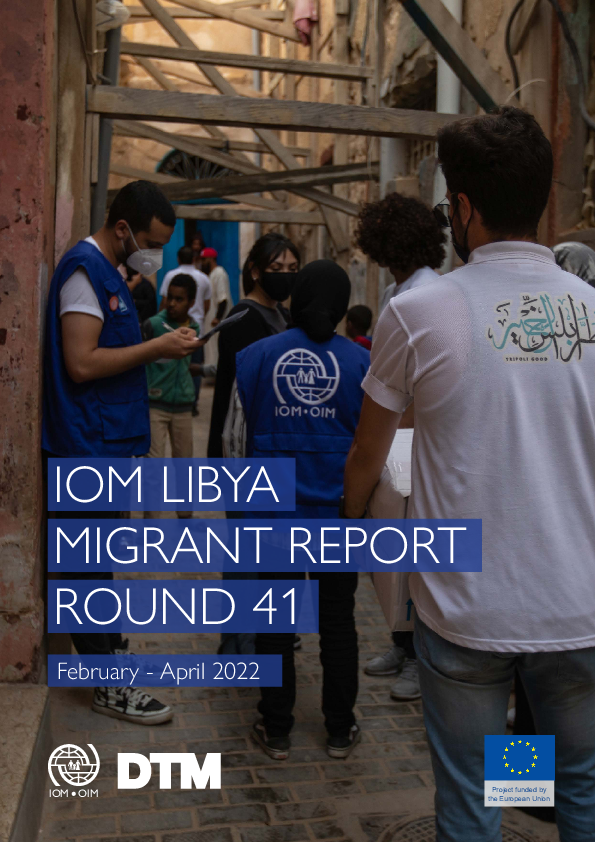
Contact
DTM Libya, DTMLibya@iom.int
Language
English
Location
Libya
Period Covered
Feb 01 2022
Apr 30 2022
Activity
- Flow Monitoring
- Migrants presence
- Mobility Tracking
- Baseline Assessment
IOM Libya’s Displacement Tracking Matrix (DTM) programme identified a total of 649,788 migrants from over 41 nationalities in the 100 Libyan municipalities during Round 41 of data collection (February - April 2022). In line with a trend that started at the beginning of 2021, data collected by DTM Libya shows that the number of migrants in Libya has continued to increase compared to the previous reporting period (635,051 migrants, Round 40, January 2022) (Fig 1). In 2020, the number of migrants in Libya declined as a result of the COVID-19 pandemic and the ensuing mobility restrictions, security controls as well as economic downturn. While the removal of the COVID-19 related mobility restrictions, improvement in the labour market (as seen in the reduced migrant unemployment rate) and cessation of armed conflict may have contributed to an increase in the number of migrants, this trend also corresponds with the arrival of seasonal migrant workers in Libya (generally between March and May).
